AGRONOMICSUPPORT
YOU CAN TAKETO THE FIELD
Common Corn Diseases: What to Watch and How to Manage
Spot the Threats Early. Act to Protect Your Yield.
As we move through August, corn crops across the Corn Belt are approaching peak development. This is the prime time for evaluating hybrid performance and projecting yield potential. But it's also when disease pressure ramps up. With timely rains and elevated humidity across much of the Midwest, it's critical to scout early and often to protect what you've worked for all season.
Corn diseases have become more aggressive over the last decade, driven by tighter rotations, reduced tillage, and shifting weather patterns. Effective management means combining field awareness, hybrid selection, and timely fungicide decisions. Below, we outline the major corn diseases to watch for, conditions that drive infection, and how to respond.
Key Corn Diseases and Symptoms
Grey Leaf Spot
Caused by Cercospora zeae-maydis, Grey Leaf Spot is one of the most widespread and yield-impacting corn diseases in the Midwest. It's favored by hot, humid weather and typically begins on lower leaves as pinpoint lesions. As it progresses, lesions become rectangular and stay between the veins. Continuous corn and no-till fields are at highest risk due to residue-borne spores. (Photo Courtesy of University of Illinois).
Northern Corn Leaf Blight
Northern Corn Leaf Blight is caused by the fungus Exserohilum turcicum and unlike Grey Leaf Spot, NCLB favors more moderate temperatures for disease to progress. The disease lesions are also long and oval and resemble a “cigar shape” and can be anywhere from 1-7” in length. The size of lesions a lot of times corresponds with hybrid susceptibility. This disease like Grey Leaf Spot can overwinter in corn residue so disease usually starts at lower leaves and works its way up the plant. Heavy dews and prolonged leaf wetness can cause more severity. When deciding on foliar treatment look at hybrid ratings and infected leaf area for treatment. Residue management in the future can also help prevent the disease in future years (Photo Courtesy of University of Nebraska-Lincoln).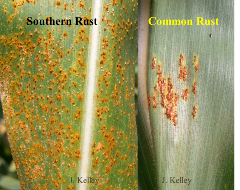
Southern Rust
Southern Rust in Corn is caused by the fungus Puccinia polysosra and has quickly became a disease to pay close attention to. The disease finds its way to the southern states and central corn belt from tropical storms that bring the spores from the south to settle on corn plants across the area. The good thing about Southern Rust is that it requires a living host to survive so it does not overwinter. Southern Rust is usually seen as a bigger threat to yield as opposed to common rust, so it is important to distinguish the two apart. Common Rust is seen on both the upper and lower leaf surfaces and is usually scattered across the plant. Southern Rust is usually located only on the upper leaf surface and is orange and dingy in color and packed closely together. It is important to scout and monitor this disease because the earlier the infection, the greater the yield loss. Fungicides can help in controlling the spread and yield loss but hybrid selection is also key in disease management. Southern States and areas with a history of southern rust should avoid hybrids with low ratings (Photo Courtesy of the University of Arkansas).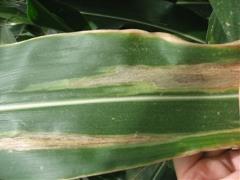
Goss’ Wilt
Goss’s Wilt is actually a bacteria rather than a fungus. It is caused by the bacterium Clavibacter michiganensis subsp. Nebraskensis. It was first found in the state of Nebraska and since has found its way in other states in the Midwest and can cause substantial yield loss. It is identified predominantly as a leaf blight and has a “water soaked” appearance with “black 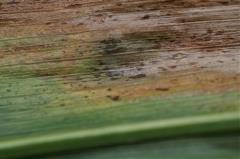 freckles” that cannot rub off. Early mornings or after a rain sometimes you can see bacterial ooze or when dry shows a shiny appearance. Infected plants show symptoms of droughty conditions and premature death of the plant. Conditions that favor the bacterial disease are hail damage or high winds that create entry points for the disease and wind driven rain can spread the bacteria. The disease can also overwinter in residue. Due to being a bacterium, fungicides cannot slow or prevent the disease. Our best line of attack is hybrid resistance so in areas with a history of goss’s wilt, strong scores against goss’s wilt should be a priority (Photos courtesy of Iowa State University).
freckles” that cannot rub off. Early mornings or after a rain sometimes you can see bacterial ooze or when dry shows a shiny appearance. Infected plants show symptoms of droughty conditions and premature death of the plant. Conditions that favor the bacterial disease are hail damage or high winds that create entry points for the disease and wind driven rain can spread the bacteria. The disease can also overwinter in residue. Due to being a bacterium, fungicides cannot slow or prevent the disease. Our best line of attack is hybrid resistance so in areas with a history of goss’s wilt, strong scores against goss’s wilt should be a priority (Photos courtesy of Iowa State University).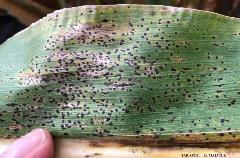
Tar Spot
Tar Spot is a relatively new disease to the United States first confirmed in 2015. It is caused by the fungus Phyllachora maydis. When it was first discovered it was seen late in the growing season and very little yield impact was observed. In 2018 a yield reduction was observed across multiple states and since then more pathologists and universities began studying the disease closer to learn about management practices and control. It is identified as round raised black lesions scattered across the leaf surface on both live and dead tissue. There is still a lot to learn about this disease, but one observation that we seem to find is hybrids with overall healthy leaf disease scores tend to tolerate the disease more than hybrids with more average scores. We will hopefully have a better understanding of this disease and what to do in the future (Photo Courtesy of the University of Minnesota).
Disease Pressure Drivers
Understanding why disease develops is as important as knowing what it looks like. Common drivers include:
- Weather conditions: Extended leaf wetness and humidity accelerate disease spread.
- Crop rotation: Continuous corn increases inoculum and disease carryover.
- Hybrid susceptibility: Varieties with lower resistance can escalate outbreaks.
- Residue levels: No-till fields provide a home for overwintering pathogens.
High-risk fields often benefit from earlier fungicide timing and increased scouting.
Scouting and Identification
Timely scouting is your first line of defense. Here's how to do it right:
- Timing: Start at V5–V10 for early symptoms; scout again from VT through R3 to assess spread and treatment thresholds.
- Patterns: Walk fields in a W or zig-zag to catch variability.
- Documentation: Record lesion type, position on the plant, and canopy coverage.
- Diagnostics: Use tissue testing if nutrient stress is suspected; track weather to predict outbreaks.
Early detection, especially in susceptible hybrids, can dramatically reduce yield loss.
Fungicide Timing and Selection
Fungicides aren’t always necessary, but when they are, timing and selection matter.
Application windows:
- V5–V7: Early protection for fields with heavy residue or history of disease.
- VT–R1: Broad-spectrum protection at a key yield stage.
Selection tips:
- Use multiple modes of action to reduce resistance risk.
- Match products to target diseases (tar spot, GLS, rust).
- Evaluate ROI based on pressure, hybrid ratings, and weather outlook.
Post-application scouting is key to verifying control.
Hybrid Selection and Integrated Management
Preventing disease begins with smart product placement and cultural practices.
- Select LG Seeds hybrids with strong disease scores suited to your geography.
- Use rotation and tillage to break disease cycles in continuous corn.
- Plant early to avoid peak infection windows.
- Leverage scouting insights to refine hybrid and management decisions next season.
A proactive approach protects yield not just this year, but in the years ahead.
Stay Ahead of Disease Before It Costs You
Corn diseases can spread fast and take down yield even faster. But with the right combination of scouting, hybrid choice, and fungicide strategy, you can manage pressure and stay in control.
Need help diagnosing or treating a disease? Contact your local LG Seeds STAR Partner or Technical Team Agronomist.
References
https://www.extension.purdue.edu/extmedia/bp/bp-56-w.pdf
https://www.extension.purdue.edu/extmedia/BP/BP-84-W.pdf
https://www.extension.purdue.edu/extmedia/BP/BP-82-W.pdf
https://www.extension.purdue.edu/extmedia/bp/BP-81-W.pdf
https://www.extension.purdue.edu/extmedia/BP/BP-90-W.pdf




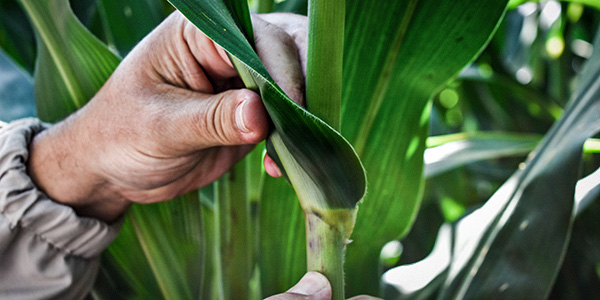
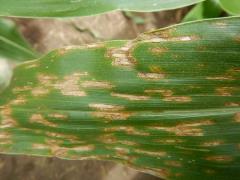
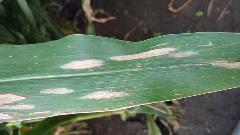

Technical Team Agronomist